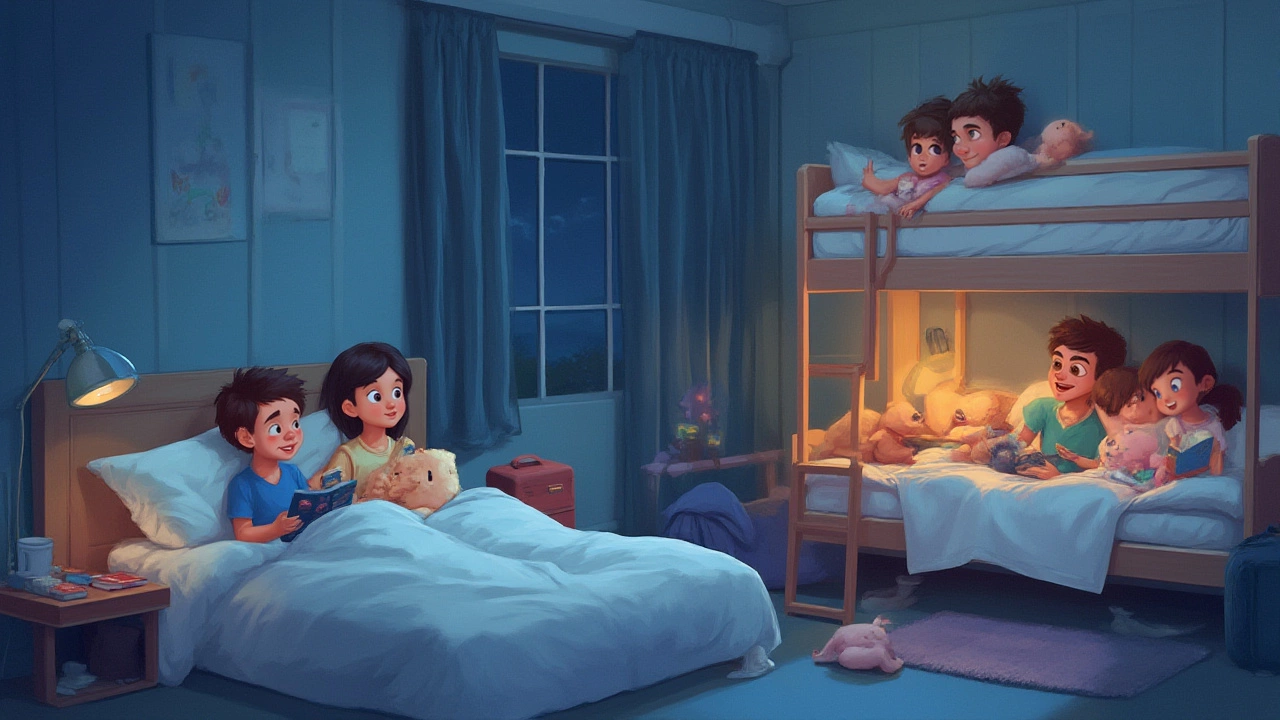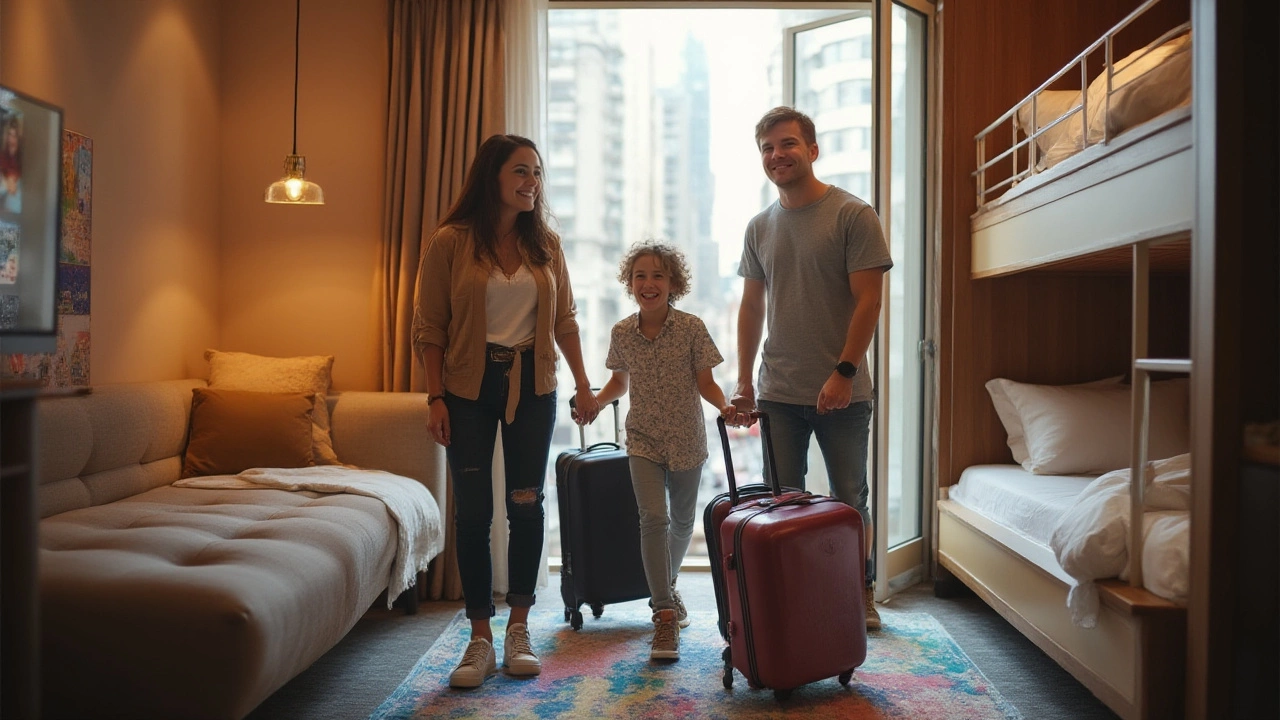Hotel policies can make you feel like you need a PhD just to book a night with your kids. If you've ever stood at the check-in counter with a squirmy toddler and a backpack of snacks, you know the awkward dance: is this room really allowed for the four of us? Some places make it easy, with family suites and bunk beds. Others act like each kid is a fire hazard. The line between 'just right' and 'packed in like sardines' gets blurry fast when you're juggling two adults and two children after a long day of travel. This isn't just about squeezing into a bed; it's about finding a space where the whole family actually sleeps well and nobody wakes up with somebody's elbow in their ear.
What Hotels Really Allow: Rules, Room Types, and What to Watch Out For
The catch about whether a family of four can stay in one hotel room: it depends. Most hotels around the world will let two adults and two kids share one room, but the fine print is where the headaches start. If both kids are under a certain age—usually twelve—hotels are much more flexible. Some brands hand out rollaway beds or cribs, throw in free breakfast for the kids, and let you upgrade to rooms with two queen beds without eye-watering fees. Others care about fire safety codes, not your family harmony. If the local laws say a maximum of three people, that’s what the front desk will enforce, with zero room for negotiation. It's why double-checking the ‘maximum occupancy’ policy is just as important as checking the Wi-Fi speed.
Big hotel chains like Marriott, Hilton, and Holiday Inn Express tend to be your best friend when you're traveling as a four-pack. They have family rooms designed to handle chaos: two proper beds—not just a sofa bed with lumpy springs. Some even have bunk beds (IKEA-style, but without the arguments about putting them together). Budget or boutique hotels play by their own rules. The definition of 'double' or 'twin' beds can change from city to city—or even building to building. In Tokyo, a double bed basically fits one and a half humans, sideways. In Florida, you'll find two kings and a pull-out couch in a room so big it feels empty. If you're staying in Europe or Asia, prepare for stricter rules and smaller rooms. Hotel rooms there are measured in centimeters you can feel. Be sure you’re not running afoul of the fire marshal just by booking a room that seems big online.
And don’t trust pictures on booking sites—they’re staged for Instagram, not real families. Always read the room description and scroll down for the tiny occupancy numbers. Many European hotels offer adjoining rooms or family suites, but you have to request them early (think months, not days, before your trip). If you’re using a booking engine like Booking.com, Expedia, or Tripadvisor, add the ages of your kids when searching; the site will often only show rooms that legally accommodate your group.
Ask the hotel, in writing, what their policy is about kids, rollaway beds, and maximum guests. Some hotels charge a ‘third or fourth person’ fee, and others throw in cribs for free but expect you to wrestle with tangled sheets at midnight. If you’re traveling with teens who look older, check the age cutoffs—otherwise you’ll be sneaking them in like you’re MacGyver on vacation. Fire codes, insurance, and safety might mean that even well-meaning front desk staff have to say no to crowding all of you into one queen bed even though you made it work last year.

How Families Can Make Hotel Rooms Work Without Losing Their Minds
So, say you’ve found a hotel that claims it fits a family of four—how do you actually make it comfy? It comes down to sleeping space, luggage juggling, and setting up a bedtime routine that won’t end in a meltdown (yours or the kids’). If your room comes with two queen beds, hallelujah. That’s close to American dream territory, especially if your kids are still small enough to share. If you’re in the land of two doubles or the dreaded ‘one king with a pullout,’ strategize early. Put the heavier sleeper with the lighter, use the walls to your advantage, and—if you’re desperate—rotate bodies perpendicular to the headboard to make legroom for smaller kids.
Bring along a white noise machine or use free apps to block out hall noise—elevators, cleaning carts, and late-night partiers make it tough for anyone to rest, especially overtired kids. Blackout curtains are your secret weapon. If your kids still nap, check if the hotel room faces away from busy streets or is higher up. Sometimes, packing an eye mask or travel pillow for each kid saves hours of whining. Older kids might prefer a sleeping bag, especially if you’re using the floor (ask first—some hotels will not allow you to lay out bedding for safety reasons).
Luggage storage is another battleground. Maximize vertical space by stacking bags, and use the closet for more than just hanging clothes—shoes, snacks, even strollers go up there. If your kids come with nine plush toys, make a rule that only one gets bed privileges. Use packing cubes, or big ziplock bags, to keep everyone’s clothes organized. Tip: If you’re staying more than a night, unpack just enough for the kids; otherwise, they’ll ransack the suitcase by breakfast.
Want everyone to wind down after a busy day? Make it a ritual: hotel picnics on the floor, a game of cards, or a family movie on a laptop or streaming from the TV. If space is tight, one parent can take restless kids for a walk around the lobby while the other sets up beds or gets showers done. The trick is dividing and conquering without anyone exploding. If your hotel room has a microwave or mini-fridge, you’re golden. Stock up on snacks and simple breakfast foods so you’re not fighting for the first spot in the lobby breakfast line. Some parents bring travel kettles for warm milk or instant oatmeal—an absolute lifesaver when everyone is running low on patience.
For bathroom traffic jams, streamline routines. Pack extra washcloths, toothbrushes, and refillable water bottles. Use the sink for quick kid baths if the bathroom doesn’t have a tub. If you’re sharing one bathroom, set a timer or play music to keep kids moving in and out. Teenagers will try to claim too much mirror time, so set expectations early. And if you can, grab a hotel room with a split bathroom or a sink outside the main bath—that tiny luxury can make a huge difference.
Here’s the real test: can you actually enjoy your stay as a family of four in one room? With a bit of creativity—and a lot of patience—you can. Treat it like a camping trip with beds (and slightly better plumbing). Make up games for bedtime, rotate who gets the window side of the bed, and celebrate small wins—like nobody getting toothpaste on the sheets. If things go south, remember that the stories you’ll tell later will be way funnier than how they felt in the moment.

Money, Comfort, and Smart Upgrades: Stretching Your Hotel Dollar for Families
Booking one room for four saves cash, but there’s a fine line between frugal and frazzled. If the kids are tiny, you’ll probably all fit—even if it’s not pretty. As they get older and longer, though, comfort drops fast. The secret sauce? Research and flexibility. Look for family hotel room deals, loyalty program perks, and free breakfast offers. Brands like Premier Inn (in the UK) and Novotel (in Europe) market hard to families, and you’ll find bigger rooms and sleeping arrangements that work. In the U.S., Residence Inn, Embassy Suites, and Homewood Suites offer suites with kitchens and pull-outs for less than two standard rooms.
Booking directly with the hotel, instead of through third-party sites, sometimes gives you more negotiating room for a free upgrade or late checkout. If your kids look under-aged (and they are!), don’t be shy about asking for a crib or rollaway—they’re often free, or at least cheaper than booking a whole second room. For special occasions—birthdays, holidays—tell the hotel. Some properties throw in goodies like cookies, small toys, or room upgrades just to make your family’s stay a little more magical.
If the budget stretches, consider connecting rooms instead of one suite. It’s usually less than the cost of a huge suite, and everyone gets their own space (and bathroom). If you’re worried about sneaky toddlers, ask for connecting rooms with an internal door—not ones at the end of a fire escape. Traveling outside the high season or midweek? Prices drop, crowds thin out, and you’ll have more options for the room you want. Don’t forget Airbnb or family-friendly vacation rentals as a backup; sometimes you can score an apartment or flat with a kitchen and separate sleeping spaces for the price of one cramped hotel room.
Loyalty programs add up. If you’re a member of hotel rewards schemes, ask about free upgrades, welcome packages, or larger family rooms. Even if you haven’t stayed before, just joining and showing the app at check-in could land you vouchers for breakfast or late check-out—game-changer on travel days. Always double-check what’s included; a free breakfast for kids, parking, or a pool can add value that makes up for a tight space.
And don’t let the perfect be the enemy of the good. As long as you’ve got everyone safe, relatively rested, and ready for adventure, sharing one hotel room can be a bonding (or at least memorable) part of the trip. If you’re honest with your expectations—and don’t try to pretend you’re the Brady Bunch—you’ll actually find what works for your crew.
In the end, finding one hotel room for four is totally doable—with the right approach. Put in a little research, ask the right questions, and pack your sense of humor. The memories (and occasional chaos) are part of the deal. Trust me, no family ever reminisced about having too much space—but they do laugh about 'remember when we all slept in the same bed that week?' and somehow, that’s the best souvenir of all.
